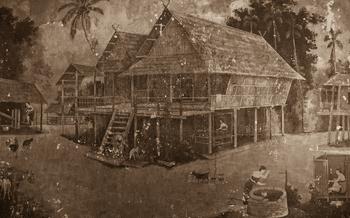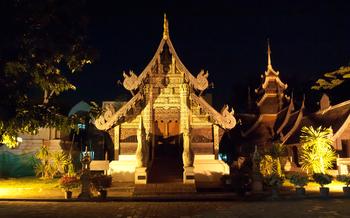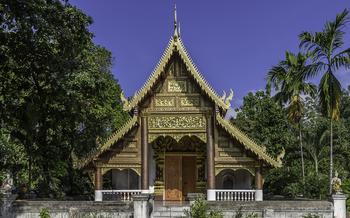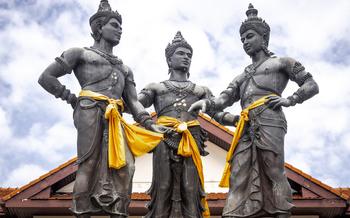
Ban Mae Yen Weaving Village
- Ban Mae Yen Weaving Village: A Tapestry of Traditions
- Weaving Workshops: A Hands-on Experience
- Showcasing Masterpieces: The Ban Mae Yen Textile Museum
- Cultural Performances and Demonstrations
- Shopping for Unique Souvenirs
- Exploring the Village's Natural Surroundings
- Homestays and Local Cuisine
- Interacting with the Weavers
- The Importance of Sustainable Tourism
- Getting to Ban Mae Yen
- Planning Your Visit
- Photography and Etiquette
- Local Festivals and Events
- Volunteering Opportunities
- Insider Tip: Unveiling a Hidden Gem
Ban Mae Yen Weaving Village: A Tapestry of Traditions
Nestled amidst the tranquil landscapes of Phrae, Thailand, lies the Ban Mae Yen Weaving Village, a testament to the enduring spirit of traditional Thai textiles. Founded over a century ago by skilled weavers who sought refuge from political turmoil, the village has become renowned for its unique weaving techniques and vibrant textiles that have captivated the hearts of textile enthusiasts worldwide.
The village's weaving heritage is deeply intertwined with its cultural identity, passed down from generation to generation through intricate patterns, vibrant colors, and meticulous craftsmanship. Each textile tells a story, reflecting the village's rich history, beliefs, and connection to nature.
At the heart of Mae Yen textiles lies the use of natural dyes, extracted from local plants and minerals, which impart a unique and vibrant palette. The weavers skillfully blend these dyes to create intricate patterns and motifs, often inspired by nature, folklore, or everyday life.
From delicate silks to sturdy cottons, the textiles of Ban Mae Yen showcase the diversity of Thai weaving traditions. Visitors can marvel at the intricate designs of silk scarves, the vibrant colors of cotton blankets, and the intricate patterns of traditional costumes, each piece a testament to the weavers' mastery and creativity.
Weaving Workshops: A Hands-on Experience
Visitors to Ban Mae Yen have the unique opportunity to learn traditional weaving techniques firsthand through immersive workshops conducted by skilled weavers. These workshops provide a glimpse into the intricate art of textile creation, allowing participants to experience the process from start to finish. Under the patient guidance of the weavers, visitors can learn how to prepare the yarn, set up the loom, and create their own woven masterpieces.
The workshops are designed to be accessible to people of all skill levels, from complete beginners to those with some weaving experience. Participants can choose from a variety of projects, such as scarves, bags, or cushion covers, and customize their designs using a wide range of colors and patterns. As they work, the weavers share their knowledge and stories, providing insights into the cultural significance of their craft.
The experience of participating in a weaving workshop is not just about creating a souvenir; it is about immersing oneself in the local culture and gaining a deeper understanding of the traditional arts of Thailand. The sense of accomplishment and cultural immersion that comes from creating a beautiful woven piece is a truly rewarding experience.
Showcasing Masterpieces: The Ban Mae Yen Textile Museum
Nestled amidst the vibrant village of Ban Mae Yen lies a treasure trove of exquisite textiles, the Ban Mae Yen Textile Museum. A testament to the village's rich weaving traditions, the museum houses an awe-inspiring collection of traditional costumes, household items, and decorative pieces, each a masterpiece in its own right.
As you step into the museum, you are greeted by a symphony of colors and patterns, a breathtaking display of the village's textile heritage. Traditional costumes, adorned with intricate embroidery and vibrant hues, tell stories of the village's past, showcasing the artistry and craftsmanship that have been passed down through generations.
Household items, such as intricately woven baskets, mats, and blankets, reflect the practical and aesthetic aspects of the village's weaving traditions. Decorative pieces, ranging from wall hangings to table runners, showcase the weavers' creativity and their ability to transform everyday objects into works of art.
The museum not only displays these exquisite textiles but also shares the stories behind their creation. Through informative panels and guided tours, visitors gain insights into the lives of the weavers, their inspirations, and the techniques they employ to create such stunning masterpieces.
The Ban Mae Yen Textile Museum stands as a repository of cultural heritage, a place where the traditions of the past are preserved and celebrated. It is a must-visit destination for anyone interested in textiles, Thai culture, or simply the beauty of handcrafted artistry.
Cultural Performances and Demonstrations
Ban Mae Yen Weaving Village is not just a place of textile production; it is also a vibrant hub of cultural expression. Visitors to the village can immerse themselves in the rich cultural heritage of the region through captivating performances and demonstrations.
Lively traditional dances, accompanied by rhythmic music and colorful costumes, bring the village's history and culture to life. These performances showcase the grace, agility, and artistry of the local dancers, who have mastered the art of storytelling through movement.
In addition to dance performances, visitors can witness demonstrations of various weaving techniques and processes. Skilled weavers provide step-by-step explanations, allowing visitors to gain a deeper understanding of the intricate craftsmanship that goes into each textile creation.
Storytelling sessions and interactions with local artisans offer a unique opportunity to learn about the lives of the weavers, their inspirations, and the challenges they face. These interactions provide a glimpse into the human side of the village's textile tradition, adding depth and meaning to the experience.
Through these cultural performances and demonstrations, visitors to Ban Mae Yen Weaving Village gain a deeper appreciation for the vibrant traditions that make this village so special. They leave with not only a newfound respect for the craft of weaving but also a deeper understanding of the rich cultural heritage of northern Thailand.
Shopping for Unique Souvenirs
Ban Mae Yen is a shopper's paradise, offering a wide variety of handwoven textiles, garments, and accessories. Visitors can purchase directly from the weavers, supporting local artisans and contributing to the preservation of their craft. The village is renowned for its intricately patterned textiles, which are often used to create traditional costumes, household items, and decorative pieces. From colorful scarves and shawls to stylish handbags and cushion covers, there is something for every taste and budget. Bargaining is acceptable, and visitors are encouraged to engage with the weavers to learn more about the textiles and their cultural significance. Shopping in Ban Mae Yen is not just about acquiring beautiful souvenirs; it is also an opportunity to support the local economy and contribute to the sustainability of this vibrant weaving community.
Exploring the Village's Natural Surroundings
Beyond the vibrant textiles and cultural experiences, Ban Mae Yen offers visitors a serene escape into nature's embrace. The village is nestled amidst a breathtaking landscape of verdant rice paddies, lush forests, and cascading waterfalls. Visitors can embark on scenic hiking trails, immersing themselves in the tranquil atmosphere and connecting with the natural beauty that surrounds the village. Whether it's witnessing the golden hues of a sunrise over the rice fields, breathing in the fresh air amidst the forest trails, or capturing the mesmerizing sight of a waterfall, Ban Mae Yen offers a harmonious blend of cultural heritage and natural wonders.
Homestays and Local Cuisine
Immerse yourself in the heart of Ban Mae Yen by staying overnight in a village homestay. These homestays offer a unique opportunity to experience the authentic lifestyle of the villagers, sharing meals, conversations, and cultural exchanges. Wake up to the sound of roosters crowing and the smell of fresh jasmine rice cooking over a wood fire. Join your hosts in their daily activities, whether it's tending to the rice fields, weaving intricate textiles, or preparing traditional dishes using locally sourced ingredients.
Savor the flavors of northern Thai cuisine, renowned for its bold and spicy flavors. Sample the famous khao soi, a rich coconut-based curry noodle soup, or try the fiery larb, a minced meat salad bursting with chili and herbs. Indulge in sticky rice, a staple of Thai cuisine, accompanied by a variety of curries, grilled meats, and fresh vegetables. Learn about traditional cooking methods passed down through generations, and discover the secrets behind the unique flavors of northern Thai cuisine.
Homestays also provide a platform for cultural exchange. Share stories with your hosts, learn about their way of life, and gain insights into the challenges and aspirations of the village community. Experience the warmth and hospitality of the villagers as they welcome you into their homes and share their traditions with you. Create lasting memories and forge connections that go beyond the superficial tourist experience.
Interacting with the Weavers
The villagers of Ban Mae Yen are renowned for their warmth and hospitality, and visitors are welcomed with open arms. Engaging in conversations with the weavers is a delightful way to learn about their lives, their craft, and their community. They are eager to share their stories, their challenges, and their aspirations. Visitors can ask about the intricate techniques they use, the inspiration behind their designs, and the role of weaving in their daily lives. The weavers are passionate about their craft and take pride in their work. They are happy to explain the processes involved in creating their beautiful textiles and to demonstrate their skills. Interacting with the weavers is a unique opportunity to gain insights into the lives of these talented artisans and to appreciate the artistry and dedication that goes into each piece they create. Building connections with the weavers and learning about their culture creates a deeper understanding of the village and its traditions, making the visit to Ban Mae Yen a truly enriching and memorable experience.
The Importance of Sustainable Tourism
Promoting sustainable tourism practices is crucial for protecting the environment and culture of Ban Mae Yen. Visitors should minimize their ecological footprint by using public transportation or walking instead of driving, reducing plastic waste, and respecting the village's natural beauty. Supporting initiatives that empower local artisans and ensure fair compensation helps sustain the village's weaving tradition. Visitors can contribute by purchasing directly from weavers, participating in workshops, and sharing their experiences with others. Responsible tourism ensures that the village's unique cultural heritage can be preserved for future generations to appreciate.
Getting to Ban Mae Yen
Reaching Ban Mae Yen from major cities in Thailand is a breeze. From Bangkok, hop on a direct bus from the Northern Bus Terminal (Mo Chit) or take a train to Den Chai Station, followed by a short bus or taxi ride. Chiang Mai also offers direct buses to Ban Mae Yen, departing from the Arcade Bus Station. If you prefer a scenic journey, opt for the train from Chiang Mai to Den Chai, followed by the same onward connections.
For a more flexible and personalized experience, rent a car or hire a private driver. The drive from Bangkok takes approximately 8-9 hours, while from Chiang Mai, it's a leisurely 3-4 hour journey. Along the way, you'll be rewarded with picturesque landscapes and charming rural vistas.
To plan your transportation effectively, here are some travel time and estimated cost estimates:
- Bus from Bangkok: 8-9 hours, around 500-600 THB
- Train from Bangkok to Den Chai: 10-12 hours, around 300-400 THB (plus onward transportation)
- Bus from Chiang Mai: 3-4 hours, around 200-300 THB
- Train from Chiang Mai to Den Chai: 4-5 hours, around 150-200 THB (plus onward transportation)
- Car rental: around 1,000-1,500 THB per day (plus fuel)
Navigating public transportation in Thailand is relatively easy. Buses and trains are reliable and affordable, with frequent departures throughout the day. If you're unsure about routes or schedules, don't hesitate to ask for assistance at the bus terminal or train station. For a hassle-free experience, consider booking a tour that includes transportation to and from Ban Mae Yen.
Planning Your Visit
To make the most of your visit to Ban Mae Yen, careful planning is key. The best time to visit is during the dry season, from November to February, when the weather is pleasant and suitable for outdoor activities. Aim to stay for at least two days to fully immerse yourself in the village's culture and traditions. Pack comfortable clothing, sturdy footwear for exploring the surroundings, and a camera to capture the vibrant textiles and landscapes. Health-wise, come prepared with insect repellent, sunscreen, and any essential medications. Remember to be respectful and mindful of local customs, such as removing your shoes before entering a home or temple.
Photography and Etiquette
When visiting Ban Mae Yen, it is crucial to be respectful of the villagers and their culture. Always ask permission before taking photographs of people, especially women and children. Be mindful of cultural customs and avoid capturing images that may be considered intrusive or disrespectful.
When photographing the village, focus on capturing its essence and beauty. Highlight the vibrant colors of the textiles, the intricate designs, and the serene landscapes. Avoid disruptive behavior, such as using flash photography or tripods, which may disturb the weavers or disrupt village life.
Remember, the goal is to document your experience while respecting the privacy and traditions of the Ban Mae Yen community. By following these guidelines, you can showcase the village's beauty and contribute to its preservation through responsible photography.
Local Festivals and Events
Ban Mae Yen comes alive during its annual festivals, showcasing the vibrant traditions and cultural heritage of the village. One of the most significant events is the Mae Yen Weaving Festival, held in January or February. During this festival, the village transforms into a kaleidoscope of colors as locals and visitors gather to celebrate the art of weaving. Weavers display their finest creations, participate in weaving competitions, and share their knowledge and skills with enthusiasts. The festival is a feast for the eyes, filled with parades, performances, and demonstrations that highlight the village's rich cultural legacy.
Other notable events include the Songkran Festival in April, where villagers engage in water-splashing rituals to mark the Thai New Year. The Loy Krathong Festival in November is another highlight, when locals float beautifully decorated krathongs (floating baskets) on the river to pay respect to the water spirits. These festivals offer visitors a chance to immerse themselves in the village's vibrant culture, witness traditional rituals, and connect with the warm and welcoming community of Ban Mae Yen.
Volunteering Opportunities
For those seeking a more immersive experience, volunteering opportunities in Ban Mae Yen offer a chance to give back to the community while learning from the locals. Visitors can contribute to various initiatives, such as teaching English to children, assisting with community development projects, or participating in conservation efforts. Volunteering provides a unique opportunity to connect with the villagers on a deeper level, share skills and knowledge, and make a meaningful impact on the community's well-being. Whether it's for a few days or a few weeks, volunteering in Ban Mae Yen is a rewarding experience that allows visitors to immerse themselves in the village's culture and traditions while making a positive contribution.
Insider Tip: Unveiling a Hidden Gem
Beyond the bustling market and vibrant workshops, Ban Mae Yen holds a secret gem waiting to be discovered. Tucked away amidst lush greenery and tranquil rice paddies, a hidden viewpoint offers breathtaking panoramas of the village and its surroundings. As you ascend the hill, the landscape unfolds before you, revealing a tapestry of vibrant colors and textures. The verdant rice fields, dotted with traditional wooden houses and shimmering waterways, create a picturesque scene that captures the essence of rural Thailand.
This hidden viewpoint is the perfect spot to escape the hustle and bustle of the village and immerse yourself in the serenity of nature. As you soak in the tranquil atmosphere, you can't help but feel a sense of peace and tranquility wash over you. Whether you choose to visit during the golden hour of sunrise or the magical glow of sunset, this hidden gem promises an unforgettable experience that will leave you with lasting memories.




